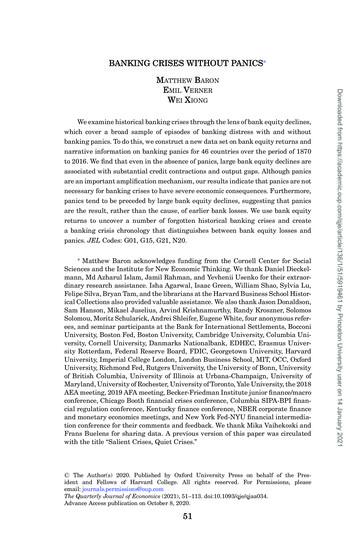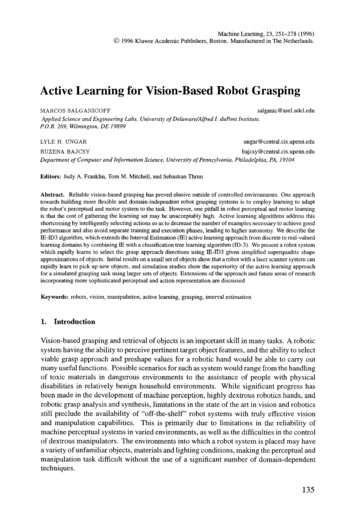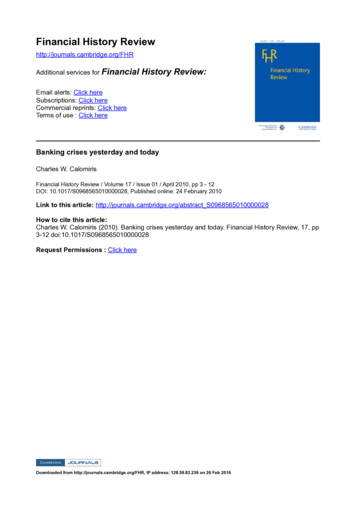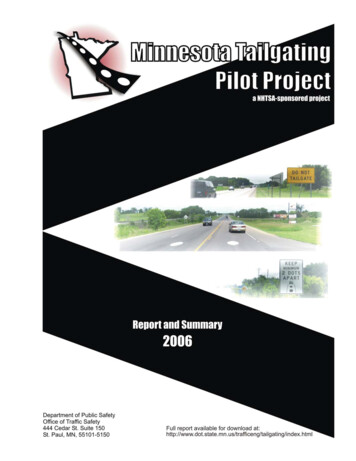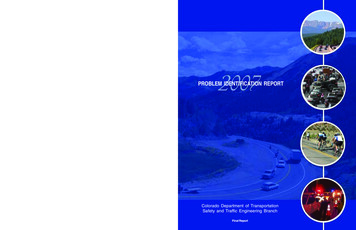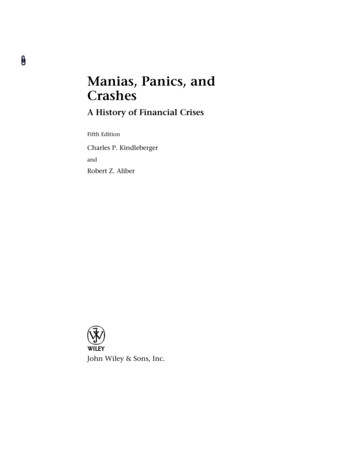
Transcription
FMJWBK120/KindlebergerFebruary 13, 200814:53Char Count Manias, Panics, andCrashesA History of Financial CrisesFifth EditionCharles P. KindlebergerandRobert Z. AliberJohn Wiley & Sons, Inc.iii
FMJWBK120/KindlebergerFebruary 13, 200814:53iiChar Count
FMJWBK120/KindlebergerFebruary 13, 200814:53Char Count Manias, Panics, and CrashesFifth Editioni
FMJWBK120/KindlebergerFebruary 13, 200814:53iiChar Count
FMJWBK120/KindlebergerFebruary 13, 200814:53Char Count Manias, Panics, andCrashesA History of Financial CrisesFifth EditionCharles P. KindlebergerandRobert Z. AliberJohn Wiley & Sons, Inc.iii
FMJWBK120/KindlebergerFebruary 13, 200814:53Char Count C2005 by Charles P. Kindleberger and Robert Z. Aliber; 1978, 1989, 1996, 2000by Charles P. Kindleberger.All rights reserved.Foreword copyright by Robert M. SolowPublished by John Wiley & Sons, Inc., Hoboken, New JerseyPublished simultaneously in CanadaNo part of this publication may be reproduced, stored in a retrieval system, ortransmitted in any form or by any means, electronic, mechanical, photocopying,recording, scanning, or otherwise, except as permitted under Section 107 or 108 of the1976 United States Copyright Act, without either the prior written permission of thePublisher, or authorization through payment of the appropriate per-copy fee to theCopyright Clearance Center, 222 Rosewood Drive, Danvers, MA 01923, 978-750-8400,fax 978-646-8600, or on the web at www.copyright.com. Requests to the Publisher forpermission should be addressed to the Permissions Department, John Wiley & Sons, Inc.,111 River Street, Hoboken, NJ 07030, 201-748-6011, fax 201-748-6008.Limit of Liability/Disclaimer of Warranty: While the publisher and the author have usedtheir best efforts in preparing this book, they make no representations or warranties withrespect to the accuracy or completeness of the contents of this book and specificallydisclaim any implied warranties of merchantability or fitness for a particular purpose. Nowarranty may be created or extended by sales representatives or written sales materials.The advice and strategies contained herein may not be suitable for your situation. Youshould consult with a professional where appropriate. Neither the publisher nor theauthor shall be liable for any loss of profit or any other commercial damages, includingbut not limited to special, incidental, consequential, or other damages.For general information about our other products and services, please contact ourCustomer Care Department within the United States at 800-762-2974, outside theUnited States at 317-572-3993 or fax 317-572-4002.Wiley also publishes its books in a variety of electronic formats. Some content thatappears in print may not be available in electronic books. For more information aboutWiley products, visit our website at www.wiley.com.Library of Congress Cataloging-in-Publication Data:Kindleberger, Charles Poor, 1910–2003Manias, panics, and crashes: a history of financial crises / Charles P. Kindleberger.—5th ed.p. cm.ISBN 978-0-471-46714-4 (pbk.)1. Financial crises. 2. Business cycles. 3. Depressions. I. Title.HB3722.K56 2005338.5 42—dc22200500106610 9 8 7 6iv
FMJWBK120/KindlebergerFebruary 13, 200814:53Char Count ContentsForeword by Robert M. Solowvii1 Financial Crisis: A Hardy Perennial12 Anatomy of a Typical Crisis243 Speculative Manias384 Fueling the Flames: The Expansion of Credit645 The Critical Stage906 Euphoria and Economic Booms1137 International Contagion1238 Bubble Contagion: Tokyo to Bangkok to New York1429 Frauds, Swindles, and the Credit Cycle16510 Policy Responses: Letting It Burn Out, and Other Devices20311 The Domestic Lender of Last Resort22512 The International Lender of Last Resort24313 The Lessons of History and the Most TumultuousDecades Ever275Appendix294Notes304Index340v
FMJWBK120/KindlebergerFebruary 13, 200814:53viChar Count
FMJWBK120/KindlebergerFebruary 13, 200814:53Char Count ForewordCharlie Kindleberger (CPK from now on) was a delightful colleague:perceptive, responsive, curious about everything, full of character, and,above all, lively. Those same qualities are everywhere evident in Manias,Panics, and Crashes.I think that CPK began to work on the book in the spirit of writing a natural history, rather as Darwin must have done at the stage ofthe Beagle—collecting, examining and classifying interesting specimens.Manias, panics, and crashes had the advantage over rodents, birds, andbeetles that they were accompanied by the rhetoric of contemporaries,sometimes with insight, sometimes just blather. It was CPK’s style as aneconomic historian to hunt for interesting things to learn, not to pursuea systematic agenda.Of course, he was an economist by training and experience, andhe soon found patterns and regularities, and causes and effects. Whatcaught his eye especially were the irrationalities that seemed so often toenmesh those directly or indirectly enmeshed in the events themselves.By itself that would have been merely entertaining. The story got interesting for CPK with the interaction of behavior and institutions. Theoccurrence of manias, panics, and crashes, and their ultimate scope, alsodepended very much on the monetary and capital-market institutionsof the time.CPK could not have known at the start just how hardy a perennialfinancial crisis would turn out to be. The quarter-century after the publication of the first edition featured a whole new level of turbulence innational banking systems, exchange-rate volatility and asset-price bubbles. There was always new material to be digested in successive editions.This history cannot have been merely the result of increasing human irrationality, though CPK would have been charmed by what a Germanfriend of ours called ‘Das Gesetz der Verschlechtigung aller Dinge’ (theLaw of the Deterioration of Everything). Increasing wealth, faster andcheaper communication, and the evolution of national and international financial systems also played an indispensable role, as sketchedin Chapter 13, added to this edition by Robert Aliber. CPK’s effort ateconomic history found a subject that does not appear to be going outof style.vii
FMJWBK120/KindlebergerviiiFebruary 13, 200814:53Char Count ForewordThe shape of a ‘new financial architecture’ and the possible utility ofa lender of last resort—national and/or international—along with theguidelines that ought to govern it were also among CPK’s preoccupations. Those who are engaged in reforming (or at least changing) thesystem would do well to ponder the lessons that emerge from this book.One of those lessons is very general, and is most applicable in contextswhere irrationality may trump sober calculation. CPK was a skeptic bynature, just the opposite of doctrinaire. He mistrusted iron-clad intellectual systems, whether their proponents were free marketeers or socialengineers. In fact, he considered clinging to rigid beliefs in the face ofdisconcerting evidence to be one of the more dangerous forms of irrationality, especially when it is practiced by those in charge. The international economy would be a safer place if CPK’s tolerant skepticism weremore common among the powers that be. I am thinking, in particular,about current discussions of the so-called ‘Washington consensus,’ andthe pros and cons of both freely floating exchange rates and unfetteredcapital markets.Any reader of this book will come away with the distinct notion thatlarge quantities of liquid capital sloshing around the world should raisethe possibility that they will overflow the container. One issue omittedin the book—because it is well outside its scope—is the other side ofthe ledger: What are the social benefits of free capital flow in its variousforms, the analogue of gains from trade? CPK, whose specialties as aneconomist included international trade, international finance and economic development, would have been sensitive to the need for somepragmatic balancing of risks and benefits. One can only hope that thecontinued, up-to-date availability of this book will help to spread hisopen-minded habit of thought.It seems to me that the Aliber version preserves this basic Kindlebergerorientation but imposes a little more order on CPK’s occasionally wayward path through his specimen cabinets. More manias, panics, andcrashes may plague us, but readers of this book will at least have beeninoculated.ROBERT M. SOLOW
c01JWBK120/KindlebergerFebruary 13, 200814:58Char Count 1Financial Crisis: A Hardy PerennialThe years since the early 1970s are unprecedented in terms of the volatility in the prices of commodities, currencies, real estate and stocks, andthe frequency and severity of financial crises. In the second half of the1980s, Japan experienced a massive bubble in its real estate and in itsstock markets. During the same period the prices of real estate and ofstocks in Finland, Norway, and Sweden increased even more rapidly thanin Japan. In the early 1990s, there was a surge in real estate prices andstock prices in Thailand, Malaysia, Indonesia, and most of the nearbyAsian countries; in 1993, stock prices increased by about 100 percentin each of these countries. In the second half of the 1990s, the UnitedStates experienced a bubble in the stock market; there was a mania inthe prices of the stocks of firms in the new industries like informationtechnology and the dot.coms.Bubbles always implode; by definition a bubble involves a nonsustainable pattern of price changes or cash flows. The implosion ofthe asset price bubble in Japan led to the massive failure of a large number of banks and other types of financial firms and more than a decadeof sluggish economic growth. The implosion of the asset price bubblein Thailand triggered the contagion effect and led to sharp declines instock prices throughout the region. The exception to this pattern is thatthe implosion of the bubble in U.S. stock prices in 2000 led to declinesin stock prices for the next several years but the ensuing recession in2001 was brief and shallow.The changes in the foreign exchange values of national currenciesduring this period were often extremely large. At the beginning of the1970s, the dominant market view was that the foreign exchange value ofthe U.S. dollar might decline by 10 to 12 percent to compensate for the1
c01JWBK120/Kindleberger2February 13, 200814:58Char Count Manias, Panics, and Crasheshigher inflation rate in the United States than in Germany and in Japanin the previous few years. In 1971 the United States abandoned the U.S.gold parity of 35 an ounce that had been established in 1934; in thenext several years there were two modest increases in the U.S. gold parityalthough the U.S. Treasury would no longer buy and sell gold. The effortto retain a modified version of the Bretton Woods system of peggedexchange rates that was formalized in the Smithsonian Agreement of1972 failed and there was a move to floating exchange rates early in1973; in the 1970s the U.S. dollar lost more than half of its value relativeto the German mark and the Japanese yen. The U.S. dollar appreciatedsignificantly in the first half of the 1980s, although not to the levels ofthe early 1970s. A massive foreign exchange crisis involved the Mexicanpeso, the Brazilian cruzeiro, the Argentinean peso, and the currencies ofmany of the other developing countries in the early 1980s. The Finnishmarkka, the Swedish krona, the British pound, the Italian lira, and theSpanish peseta were devalued in the last six months of 1992; most ofthese currencies depreciated by 30 percent relative to the German mark.The Mexican peso lost more than half of its value in terms of the U.S.dollar during the presidential transition in Mexico at the end of 1994and the beginning of 1995. Most of the Asian currencies—the Thai baht,the Malaysian ringgit, the Indonesian rupiah, and the South Koreanwon—depreciated sharply in the foreign exchange market during theAsian Financial Crisis in the summer and autumn of 1997.The changes in the market exchange rates for these individual currencies were almost always much larger than those that would havebeen inferred from the differences between national inflation rates inparticular countries. The scope of ‘overshooting’ and ‘undershooting’ ofnational currencies was both more extensive and much larger than inany previous period.Some of the changes in commodity prices in the period were spectacular. The U.S. dollar price of gold increased from 40 an ounce at thebeginning of the 1970s to nearly 1,000 an ounce at the end of thatdecade; at the end of the 1980s the price was 450, and at the end of the1990s it was 283. The price of oil was 2.50 a barrel at the beginning ofthe 1970s and 40 a barrel at the end of that decade; in the mid-1980sthe oil price was 12 a barrel and then at the end of the 1980s the pricewas back at 40 after the Iraqi invasion of Kuwait.The number of bank failures during the 1980s and the 1990s wasmuch, much larger than in any earlier decades. Several of these failureswere isolated national events: Franklin National Bank in New York City
c01JWBK120/KindlebergerFebruary 13, 200814:58Char Count Financial Crisis: A Hardy Perennial3and Herstatt AG in Cologne, Germany, made large bets on the changesin currency values in the early 1970s and both banks lost the bets andwere forced to close because of the large losses. Crédit Lyonnais, oncethe largest bank in France and a government-owned firm, made an exceptionally large number of loans associated with the effort to rapidlyincrease its size and its bad loans eventually cost the French taxpayersmore than 30 billion. Three thousand U.S. savings and loan associationsand other thrift institutions failed in the 1980s, with losses to the American taxpayers of more than 100 billion. The collapse of the U.S. junkbond market in the early 1990s led to losses of more than 100 billion.Most of the bank failures in the 1980s and the 1990s were systemic andinvolved all or most of the banks and financial institutions in a country.When the bubbles in Japanese real estate and stocks imploded, the lossesincurred by the Japanese banks were many times their capital and virtually all the Japanese banks became wards of their governments. Similarlywhen the Mexican currency and the currencies of the other developingcountries depreciated sharply in the early 1980s, most of the banks inthis group of countries failed because of the combination of their largeloan losses and the currency revaluation losses of their domestic borrowers. Virtually all of the banks in Finland, Norway, and Sweden wentbankrupt when the bubbles in their real estate and stock markets imploded at the beginning of the 1990s. (Many of the government-ownedbanks in these various countries incurred comparably large loan lossesand would have failed if they were not already in the public sector.)Virtually all of the Mexican banks failed at the end of 1994 when thepeso depreciated sharply. Most of the banks in Thailand and Malaysiaand South Korea and several of the other Asian countries went bankruptafter the mid-1997 Asian Financial Crisis (the banks in Hong Kong andSingapore were an exception).These financial crises and bank failures resulted from the implosionof the asset price bubbles or from the sharp depreciations of nationalcurrencies in the foreign exchange market; in some cases the foreignexchange crises triggered bank crises and in others the bank crises ledto foreign exchange crises. The cost of these bank crises was extremelyhigh in terms of several metrics—the losses incurred by the banks ineach country as a ratio of the country’s GDP or as a share of governmentspending, and the slowdowns in the rates of economic growth. The lossesincurred by the banks headquartered in Tokyo and Osaka—eventuallya burden on the country’s taxpayers—were more than 25 percentof Japan’s GDP. The losses incurred by the Argentinean banks were
c01JWBK120/Kindleberger4February 13, 200814:58Char Count Manias, Panics, and Crashes50 percent of its GDP—a lot of money in yen and pesos and U.S. dollars,and a much larger share of GDP than the losses incurred by U.S. banksin the Great Depression of the 1930s.These bank failures occurred in three different waves: the first at thebeginning of the 1980s, the second at the beginning of the 1990s andthe third in the second half of the 1990s. The bank failures, the largechanges in exchange rates and the asset price bubbles were systematically related and resulted from rapid changes in the economic environment. The 1970s was a decade of accelerating inflation, the largestsustained increase in the U.S. consumer price level in peacetime. Themarket price of gold surged initially because some investors relied onthe cliché that ‘gold is a good inflation hedge’ as the basis for their priceforecasts; however the increase in the gold price was many times largerthan the contemporary increase in the U.S. price level. Toward the endof the 1970s investors were buying gold because the price of gold wasincreasing—and the price was increasing because investors were buyinggold. The Hunt brothers from Texas tried to corner the silver market andthe price of this precious metal in the 1970s increased even more rapidlythan the price of gold.The prevailing view in the late 1970s was that U.S. and world inflationrates would accelerate. Some analysts predicted that the gold price wouldincrease to 2,500 an ounce; the forecasters in the oil industry and inthe banks that were large lenders to firms in the oil industry predictedthat the oil price would reach 80 to 90 a barrel by 1990. One of theclichés at the time was that the price of an ounce of gold was more orless the same as the price of twenty barrels of oil.The range of movement in bond prices and stock prices in the 1970swas much greater than in the several previous decades. In the 1970sthe real rates of return on both U.S. dollar bonds and U.S. stocks werenegative. In contrast in the 1990s the real rates of return on bonds andon stocks averaged more than 15 percent a year.The foreign indebtedness of Mexico, Brazil, Argentina, and other developing countries as a group increased from 125 billion in 1972 to 800 billion in 1982. The major international banks headquartered inNew York and Chicago and Los Angeles and London and Tokyo increasedtheir loans to governments and government-owned firms in these countries at an average annual rate of 30 percent a year for ten years. Thecliché at the time was that governments didn’t go bankrupt. During thisperiod the borrowers had a stellar record for paying the interest on theirloans on a timely basis—but then they obtained all the cash needed topay the interest on these loans from the lenders in the form of new loans.
c01JWBK120/KindlebergerFebruary 13, 200814:58Char Count Financial Crisis: A Hardy Perennial5In the autumn of 1979 the Federal Reserve adopted a sharply contractive monetary policy; interest rates on U.S. dollar securities surged. Theprice of gold peaked in January 1980 as inflationary anticipations werereversed. A severe world recession followed.In 1982 the Mexican peso, the Brazilian cruzeiro, the Argentineanpeso, and the currencies of the other developing countries depreciatedsharply, share prices in these countries tumbled, and most of the banksin these countries failed as a result of the large loan losses.The sharp increase in real estate prices and stock prices in Japan inthe 1980s was associated with a boom in the economy; Japan as NumberOne: Lessons for America1 was a bestseller in the country. The banks headquartered in Tokyo and Osaka increased their deposits and their loansand their capital much more rapidly than banks headquartered in theUnited States and in Germany and in the other European countries; usually seven or eight of the ten largest banks in the world were Japanese.Then at the beginning of the 1990s real estate prices and stock prices inJapan imploded. Within a few years many of the leading Japanese banksand financial institutions were broke, kaput, bankrupt, and insolvent,and remained in business only because of an implicit understandingthat the Japanese government would protect the depositors from financial losses if the banks were closed. A striking story of a mania and acrash—but a crash without a panic, apparently because of the belief thatgovernment would socialize the loan losses.Three of the Nordic countries—Norway, Sweden, and Finland—replicated the Japanese asset price bubble at the same time. A boom in realestate prices and stock prices in the second half of the 1980s associatedwith financial liberalization was followed by a collapse in real estateprices and stock prices and the failure of the banks.Mexico had been one of the great economic success stories of the early1990s as it prepared to enter the North American Free Trade Agreement.The Bank of Mexico had adopted a tough contractive monetary policythat reduced the inflation rate from 140 percent to less than 10 percent ina four-year period; during the same period several hundred governmentowned firms were privatized and business regulations were liberalized.Foreign capital flowed to Mexico because the real rates of return ongovernment securities were high and because the prospective profit rateson industrial investments were also high. The universal expectation wasthat Mexico would become the low-wage, low-cost base for producingautomobiles and washing machines and many other manufacturedgoods for the U.S. and Canadian markets. Because the large inflow offoreign savings led to a real appreciation of the peso, Mexico developed
c01JWBK120/Kindleberger6February 13, 200814:58Char Count Manias, Panics, and Crashesa trade deficit that reached 7 percent of its GDP. Mexico’s external debtwas 60 percent of its GDP and the country obtained the money to pay theinterest on its increasing foreign indebtedness from the inflow of newinvestments. Then several political incidents, partly associated with thepresidential election and transition in 1994, led to a sharp decline in theinflow of foreign funds, the Mexican government was unable to continueto support the peso in the foreign exchange market, and the currencylost more than half of its value in several months. Once again the depreciation of the peso resulted in large loan losses, and the Mexican banks —which had been privatized in the previous several years—failed.In the mid-1990s real estate prices and stock prices surged in Bangkok,Kuala Lumpur, and Indonesia; these were the ‘dragon economies’ thatseemed likely to emulate the economic successes of the ‘Asian tigers’of the previous generation—Taiwan, South Korea, Hong Kong, and Singapore. Japanese firms and European and U.S. firms began to invest inthese countries as low-wage, low-cost sources of supply, much as U.S.firms had invested in Mexico as a source of supply for the North American market. European and Japanese banks rapidly increased their loansin these countries. The domestic lenders in Thailand then experiencedlarge loan losses on their domestic credits in the autumn and winterof 1996 because they had not been sufficiently discriminating in theirevaluations of the willingness of Thai borrowers to pay the interest ontheir indebtedness. Foreign lenders sharply reduced their purchases ofThai securities, and then the Bank of Thailand, much like the Bank ofMexico thirty months earlier, did not have the foreign exchange reservesto support its currency in the foreign exchange market. The sharp decline in the foreign exchange value of the Thai baht in early July 1997led to capital outflows from the other Asian countries and the foreignexchange values of their currencies (except for the Hong Kong dollarand the Chinese yuen, which remained rigidly pegged to the U.S. dollar)declined by 30 percent or more. The Indonesian rupiah lost 80 percentof its value in the foreign exchange market. Most of the banks in thearea—except for those in Hong Kong and Singapore—would have beenbankrupt in any reasonable ‘mark-to-market’ test. The crises spread fromAsia to Russia, there was a debacle in the ruble, and the country’s bankingsystem collapsed in the summer of 1998. Investors then became morecautious and they sold risky securities and bought safer U.S. governmentsecurities, with the result that the changes in the relationship betweenthe interest rates on these two groups of securities caused the collapse ofLong-Term Capital Management, then the largest U.S. hedge fund.
c01JWBK120/KindlebergerFebruary 13, 200814:58Char Count Financial Crisis: A Hardy Perennial7The immense scope of the financial crashes in the last thirty years reflects in part that there are many more countries in the international financial economy and in part that data collection is more comprehensive.Despite the lack of perfect comparability across different time periods,the conclusion is unmistakable that financial failure has been more extensive and pervasive in the last thirty years than in any previous period.The 1990s bubble in NASDAQ stocksStocks in the United States are traded on either the over-the-counter market or on one of the organized stock exchanges, principally the NewYork Stock Exchange or the American Stock Exchange or one of the regional exchanges in Boston, Chicago, and Los Angeles/San Francisco. Thetypical pattern was that shares of young firms would initially be tradedon the over-the-counter market and then most of these firms would incur the costs associated with obtaining a listing on the New York StockExchange because they believed that such a listing would broaden themarket for their stocks and lead to higher prices. Some very successfulnew firms associated with the information technology revolution of the1990s—Microsoft, Cisco, Dell, Intel—were exceptions to this pattern; theychose not to obtain a listing on the New York Stock Exchange becausethey believed that trading stocks electronically in the over-the-countermarket was superior to trading stocks by the open-outcry method usedon the New York Stock Exchange.In 1990 the market value of stocks traded on the NASDAQ was 11percent of that of the New York Stock Exchange; the comparable figuresfor 1995 and 2000 were 19 percent and 42 percent. The annual averagepercentage rate of increase in the market value of NASDAQ stocks was30 percent during the first half of the decade and 46 percent during thenext four years. A few of the newer firms traded on the NASDAQ wouldeventually become as successful and as profitable as Microsoft and Inteland so high prices for their stocks might be warranted. The likelihoodthat all of the firms whose stocks were traded on the NASDAQ would beas successful as Microsoft was extremely small, since it implied that theprofit share of U.S. GDP would be two to three times higher than it everhad been previously.The bubble in U.S. stock prices in the second half of the 1990s was associated with a remarkable U.S. economic boom; the unemployment ratedeclined sharply, the inflation rate declined, and the rates of economicgrowth and productivity both accelerated. The U.S. government developed its largest-ever fiscal surplus in 2000 after having had its largestever fiscal deficit in 1990. The remarkable performance of the real economy contributed to the surge in U.S. stock prices that in turn led to
c01JWBK120/Kindleberger8February 13, 200814:58Char Count Manias, Panics, and Crashesthe increase in investment spending and consumption spending andan increase in the rate of U.S. economic growth and the spurt in fiscalrevenues.U.S. stock prices began to decline in the spring of 2000; in the nextthree years U.S. stocks as a group lost about 40 percent of their valuewhile the prices of NASDAQ stocks declined by 80 percent.One of the themes of this book is that the bubbles in real estate andstocks in Japan in the second half of the 1980s, the similar bubblesin Bangkok and the financial centers in the nearby Asian countries inthe mid-1990s, and the bubble in U.S. stock prices in the second halfof the 1990s were systematically related. The implosion of the bubblein Japan led to an increase in the flow of money from Japan; some ofthis money went to Thailand and Malaysia and Indonesia and somewent to the United States. The increase in the inflow of money led tothe appreciation of their currencies in the foreign exchange market andto increases in the prices of real estate and of securities available inthese countries. When the bubbles in the countries in Southeast Asiaimploded, there was another surge in the flow of money to the UnitedStates as these countries repaid some of their foreign indebtedness; theU.S. dollar appreciated in the foreign exchange market and the annualU.S. trade deficit increased by 150 billion and reached 500 billion.The increase in the flow of money to a country from abroad almostalways led to increases in the prices of securities traded in that countryas the domestic sellers of the securities to the foreigners used a veryhigh proportion of their receipts from these sales to buy other securitiesfrom other domestic residents. These domestic residents in turn similarlyused a large part of their receipts to buy other domestic securities fromother domestic residents. These transactions in securities occurred atever-increasing prices. It’s as if the cash from the sale of securities toforeigners was the proverbial ‘hot potato’ that was rapidly passed fromone group of investors to others, at ever-increasing prices.Manias and creditThe production of books on financial crises is counter-cyclical. A spateof books on the topic appeared in the 1930s following the U.S. stockmarket bubble in the late 1920s and the subsequent crash and the GreatDepression. Relatively few books on the subject appeared during theseveral decades immediately after World War II, presumably because therecessions from the 1940s to the 1960s were mi
appears in print may not be available in electronic books. For more information about Wiley products, visit our website at www.wiley.com. Library of Congress Cataloging-in-Publication Data: Kindleberger, Charles Poor, 1910-2003 Manias, panics, and crashes: a history of financial crises / Charles P. Kindleberger.— 5th ed. p. cm. ISBN 978--471-46714-4 (pbk.) 1. Financial crises. 2 .
